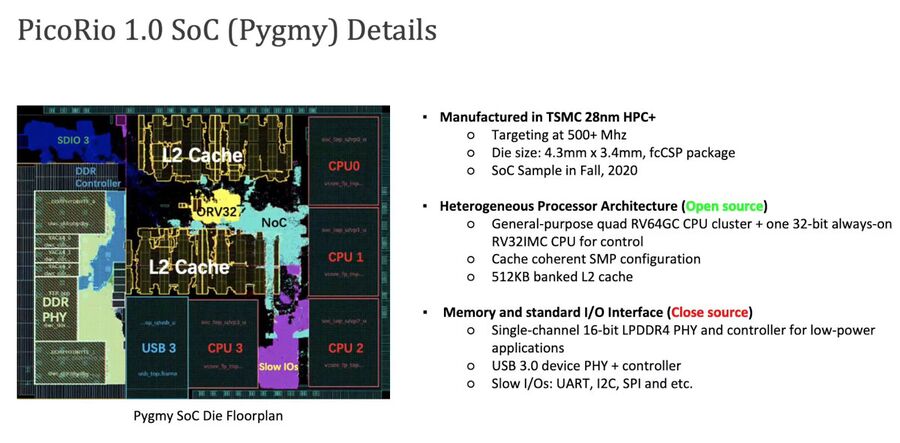The Linux-Compatible RaspberryPi-like PicoRio Pygmy RISC-V SOC Could Be A Game-Changer For RISC-V
Boards with the open RISC-V architecture has so far been extremely limited or overly expensive. There are some very cheap boards RISC-V boards like the Longan Nano out there, but 128KB Flash and 32KB SRAM put that in the microcontroller category, far below Single Board Computers. The joint American/Chinese venture RIOS aims to change that with their new PicoRio Pygmy SoC featuring a 64-bit quad-core RV64GC processor capable of running Linux.
written by 林慧 (Wai Lin) 2020-09-08 - last edited 2020-09-08. © CC BY
A cheap and readily available single board computer similar to the Raspberry Pi would make the so-far obscure and out-of-reach open RISC-V architecture available to anyone who wants to use or tinker with a system running a completely free and open instruction set. That is what the the RISC-V International Open Source (RIOS) laboratory, a joint venture between American UC Berkeley University and Chinese Tsinghua University, is trying to accomplish.
The first step towards a usable end-user product like Raspberry Pi will be the PicoRio 1.0 code-named "Pygmy". It will have a 64-bit quad-core cache-coherent processor (RV64GC) with a MMU. It will be capable of running Linux and Chromium OS. There is one slight problem with the first PicoRio version: It will not have a GPU. That minor detail makes the initial version less than ideal as a Raspberry Pi alternative. The RIOS Lab expects to have PicoRio 1.0 SoC boards shipping by the end of the year.
The next step will be the PicoRio 2.0 with a graphics card capable of running "graphics intensive applications like web browsers". RIOS is working with Imagination Technologies to incorporate a GPU in their SoC design.
A PicoRio 3.0 is also planned. The RIOS Lab has a somewhat ambitious goal for that one:
"We plan to further improve the CPU performance to bring PicoRio to the level of a pad computer or laptop"
The RIOS Lab promises to open source as much as they can. That includes the CPU, the main SoC design, the processor chip package, board design files, device drivers and firmware. Some aspects of the PicoRio boards will not be open source. The TSMC SRAM configurations and the PowerVR GPU provided by Imagination will be closed and proprietary. That raises some obvious questions.
There is currently zero free software support for the Imagination Technologies PowerVR graphics chips. The Free Software Foundation considers free PowerVR drivers to be a "high priority" and there is project trying to create free drivers for their PowerVR graphics chips but there is, as of right now, no way to power them on a Linux system. It would be a shame if the first cheap and readily available consumer RISC-V SoC board requires a proprietary binary blob driver to power the CPU.
The 4-core 64-bit RV64GC RISC-V processors for the PicoRio Pygmy will be manufactured on a 28nm process node at TSMC in Chinese Taipei. That's a huge step up from their bleeding edge 5nm process node. It is a simple matter of price. RIOS Labs is aiming for a sub-$100 price-tag.
The RicoRio 1.0 will be available for sale towards the end of the year. It will not be for everyone due to the lack of a GPU. The RicoRio 2.0 will be when it becomes available summertime 2021. That one will make it possible to run a regular GNU/Linux distribution on a RISC-V powered device powerful enough to run web browsers, media players and things like that.
You can learn more about the RIOS Lab at rioslab.org and find some preliminary information about the PicoRio at picorio-doc.readthedocs.io /en/latest/general/introduction.html.



Enable comment auto-refresher